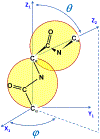Positional Distributions of the Tethered Modules in Nitric Oxide Synthase: Monte Carlo Calculations and Pulsed EPR Measurements
- PMID: 31310526
- PMCID: PMC7534783
- DOI: 10.1021/acs.jpca.9b05388
Positional Distributions of the Tethered Modules in Nitric Oxide Synthase: Monte Carlo Calculations and Pulsed EPR Measurements
Abstract
The nitric oxide synthase (NOS) enzyme consists of multiple domains connected by flexible random coil tethers. In a catalytic cycle, the NOS domains move within the limits determined by the length and flexibility of the interdomain tethers and form docking complexes with each other. This process represents a key component of the electron transport from the flavin adenine dinucleotide/reduced nicotinamide adenine dinucleotide phosphate binding domain to the catalytic heme centers located in the oxygenase domain. Studying the conformational behavior of NOS is therefore imperative for a full understanding of the overall catalytic mechanism. In this work, we have investigated the equilibrium positional distributions of the NOS domains and the bound calmodulin (CaM) by using Monte Carlo calculations of the NOS conformations. As a main experimental reference, we have used the magnetic dipole interaction between a bifunctional spin label attached to T34C/S38C mutant CaM and the NOS heme centers, which was measured by pulsed electron paramagnetic resonance. In general, the calculations of the conformational distributions allow one to determine the range and statistics of positions occupied by the tethered protein domains, assess the crowding effect of the multiple domains on each other, evaluate the accessibility of various potential domain docking sites, and estimate the interaction energies required to achieve target populations of the docked states. In the particular application described here, we have established the specific mechanisms by which the bound CaM facilitates the flavin mononucleotide (FMN)/heme interdomain docking in NOS. We have also shown that the intersubunit FMN/heme domain docking and electron transfer in the homodimeric NOS protein are dictated by the existing structural makeup of the protein. Finally, from comparison of the calculated and experimental docking probabilities, the characteristic stabilization energies for the CaM/heme domain and the FMN domain/heme domain docking complexes have been estimated as -4.5kT and -10.5kT, respectively.
Figures









References
MeSH terms
Substances
Grants and funding
LinkOut - more resources
Full Text Sources
Research Materials

